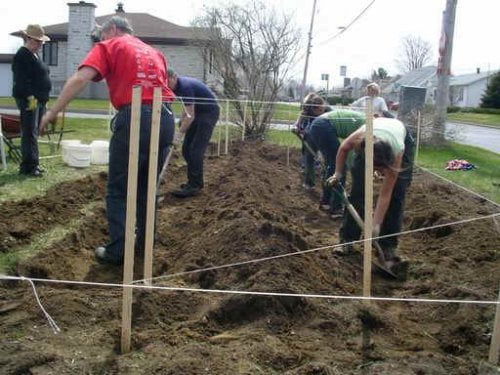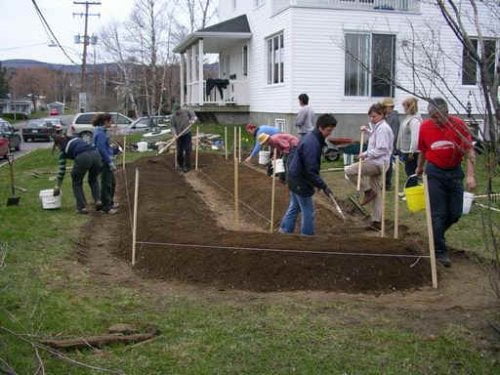There is more than one way to prepare the ground for planting. The patient approach involves no-till techniques, where organic matter is built up on top of the lawn without damaging the underlying soil structure. No-till techniques are easy to install and low-maintenance, allowing a simple garden to be planted the first year and a full garden the second year. The hurried approach involves digging or tilling, which is initially labour intensive though allows a full garden to be planted the first season. You may also consider raised beds, where beds are created above the normal ground level.
No-till techniques
At the Veganic Agriculture Network, no-till techniques are our favourite approach to gardening. Our garden in Quebec was grown directly on a lawn without ever using a shovel. In autumn 2005, part of the lawn was covered with cardboard and hay, and another part of the lawn was covered in cardboard and Chipped Branch Wood:
In no-till gardening, the basic premise is to add a thick layer of nutrient-rich material on the ground, where it suppresses weeds and slowly decomposes. This is an ideal way of protecting and feeding the soil food web, the microorganisms that keep our soils fertile. There are many approaches to creating a no-till garden. In the Ruth Stout approach, hay can be used as the sole source of fertility. Or, Chipped Branch Wood can be used as the only source of organic matter. In sheet mulching or lasagna gardening, several layers of biodegrable materials are used, such as compost and cardboard, covered with leaves, hay, twigs, and grass.
If started in the autumn, no-till gardens are ready for a full garden the following spring. If started in the spring, more robust plants like potatoes and broad beans, or transplants like tomatoes, leeks and cucumbers do well in the first year, followed by a more diverse range in future years once the organic matter has decomposed.
Digging and tilling
Rototilling: Many people rototill their gardens on a yearly basis, though we don’t recommend it: a healthy garden has significant worm populations and fungal networks, and it’s unfortunate to profoundly disrupt the organisms that keep the soil fertile. For people who are starting to garden for the first time, we’d recommend preparing the soil with no-till techniques, though rototillers are also an option for loosening the soil if you’d like a full garden the first season. Remember to remove any roots by hand, otherwise plants like grass and dandylions may pop back up. In subsequent years, it’s better for the health of the soil if you choose alternatives to tilling.
Digging: While no-till techniques are low effort, digging certainly provides exercise! Though even if we dig our gardens the first year to lighten the soil, it’s preferable for soil health to minimize digging or choose no-till techniques in future years.
To begin digging a new garden, either:
- Break apart the surface with a pitchfork. Remove weeds by hand, including their root networks (they can easily propagate on exposed soil). Mix the soil with composted organic matter.
- Or, the sod can be completely removed with a spade, and organic materials are added to help replace the lost topsoil. The sod can be composted, and eventually added back to the garden.
Double Digging: Double digging is used to create light and airy soil, allowing plant roots to go deeper rather than competing for space horizontally. In double-dug gardens, plants can be grown more densely, leading to a higher overall harvest. If starting on a lawn, the grass layer is removed completely. Then the top layer of weed-free soil is removed with a spade, and then the bottom layer is loosened with a pitchfork. Compost is mixed in, and the top layer of weed-free soil is returned. If care is taken to avoid soil compaction, double-digging doesn’t need to be repeated for several years or longer. The biointensive method uses double digging as part of an ecological method for intensive food production.
Raised beds
For raised beds, the soil is shaped into beds that are above the normal ground level. In typical raised beds the soil is piled about a foot above ground level, though the height can range from a few inches to a few feet.
Making raised beds using your own soil: Choose in advance the location of your plant beds, and the placement of your pathways. Dig the pathways lower than ground level, and use this extra soil to create raised beds. Ensure that you remove weeds and roots from the soil.


Don’t compact the soil
Whatever approach you take to starting a garden, make sure you don’t compact the soil in the area where your plants are growing. It’s important to clearly distinguish pathways between the plant beds, as stepping or kneeling in the wrong place will lead to unnecessary compaction. Plant roots and soil organisms are like us: they need water and food, but above all else, they need air. Worms and other soil organisms create air pockets as they move through the soil, keeping the soil light and airy. If we avoid compaction and tillage, we give the soil organisms and root systems the chance to perform their natural function of improving the soil structure.








